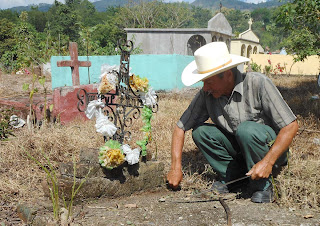 |
| The doctor is in at Angelitos Felices |
I’ve known
for a while now that accessing medical care was a challenge for the majority of
Hondurans who have to rely on the public system. But it wasn’t until I put in a
couple of days as an ad-hoc translator for a U.S. doctor in the villages this
week that I fully understood that medical care is as good as non-existent for a
whole lot of people.
The doctor
was part of a faith-based group out of Illinois and Tennessee who were here to
build fuel-efficient stoves in three villages around Copan. She hadn’t planned on
seeing patients, but word got out fast that there was a doctor among the group
and she graciously agreed to see a few people.
And they
jumped at the chance. On Monday and Tuesday we were in Guarumal, Cabanas, a village of 15 families,
and at least nine of those families were in the lineup within 10 minutes of the
doctor pulling up a chair on the patio outside a resident’s house. I suspect
the other six families would have been there, too, if they’d heard the news that
an impromptu clinic was on.
They
arrived with all the problems that any family bumps into in the course of a
life: fevered little children sick with a seasonal virus; bad coughs; yeast
infections; stomach pain; acid reflux; foot fungus; bad teeth; lumps and bumps
and itchy rashes that they’d had for years in some cases.
But unlike
a typical North American family, these ones rarely got care for their illnesses
and injuries. Even if they were able to find the $5 fee to see the doctor at
the public clinic, the nearest clinic was a long, hard 10 or 15 miles away and
many of them didn’t have transport. Nor did they have money for any necessary
lab tests to confirm what ailed them, or for medications. Not that they could
count on the scarce public health clinics in this area to even be open when
they showed up, or have the medications they needed.
The
pharmacies in Honduras are loaded with all the modern medications, and
virtually all are available without a prescription. But until a doctor gives
you a diagnosis and the name of a drug that might help, none of that means a thing.
I wouldn’t like to think how many people end up using the wrong medication for
an ailment, simply because they don’t know which one to ask for.
 |
| High-sugar diets, poor oral hygiene and no dental care is a recipe for pain and problems for impoverished Honduran children. |
So while the
people in Guarumal were grateful that the visiting doctor sometimes pulled a
free bottle of painkillers or antibiotics out of her magic bag, they were
equally appreciative just to have her write down the name of the medication
they needed. Money is one hurdle, but
knowing what drug to buy is an additional barrier.
The good
doctor let me lure her to the Angelitos Felices foster home as well, where 25
or so kids pass their days in unsanitary, damp conditions in which they share
towels, clothes, bedding, shoes and therefore all the diseases and infections that
spread that way. I’d cautioned her that the kids might be shy about being
examined, but in fact most of them really seemed to like the personal
attention, not to mention the chance to get a band-aid (or two or three) on
their many cuts and scrapes.
I came home
with a list of suggested medications for all the kids with ailments, with an
asterisk by the ones who need treatment most urgently. That included a
two-year-old and a four-year-old who both have severe staph infections on their
scalps, a nine-year-old suffering from a monstrous tooth ache from the worst of
his many cavities, and a 14-year-old with a urinary tract infection. (Wish I could
have done something for the asthmatic little boy we met in Guarumal, who was so
obviously struggling for every breath.)
The doctor says
just about every child in Angelitos has a chronic fungal infection on their
feet, and some have it on their faces and scalps. So I bought a big tube of
anti-fungal cream at the pharmacy this morning and am going back for two more
when the next shipment arrives from San Pedro next week. Clearing the fungus
out of that place sounds like an impossible task, but even a month or two
without cracked, achy feet should be a relief for those kids.
Spare a
thought for them next time you’re grumbling about the wait at the walk-in
clinic or the lineup at the pharmacy. The people here would be ecstatic if that
was as big as the problems got.


.jpg)



